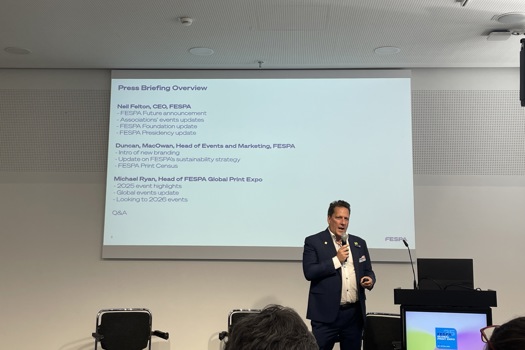The first Rotek pile turner model was the 900P/A, launched in the early 1980s. Initially, there was only one lift type in the range – fork – but the firm offered a platform variation a decade later. “In 1998, the platform lift was introduced and it is by far the most popular, although the fork version is still available,” says Stuart Bamford, UK and Ireland sales manager for Freidheim International’s post-press division, which distributes for Rotek in the UK.
Air or vibration
Optional features include air separation on the fork model and air or vibration on the platform model. With air separation, the machine blows air through the pallets to remove excess paper dust and fibres before the paper is turned and sent to the press, explains Bamford. The dust removal results in better print quality as dust marks and fibres are eliminated from the printed product. The jogging or vibration ensures the sheets are properly aligned. Changes on the platforms are not retrofittable.
At Ipex last year, Astek Engineering introduced a new model of Rotek, the 2000, which is a large-format pile turner that can handle sheets up to 1,200x1,600mm. Freidheim claims that no other pile turner on the market can turn sheets of that size. “Anyone buying a large-format press should also buy the 2000,” says Bamford.
Last month, secondhand dealer Roberts Graphics, which sells used Rotek pile turners, announced that it had sold a 2000 to The Studio in the UK. The pile turner was purchased to work alongside the company’s new Heidelberg Speedmaster CD 102-6.
The names of the Rotek models relate to the weight of the stack of paper the machine can handle. So the 900 can handle a maximum pile of 900kg, while the 2000 can handle 2,000kg. There are three versions of the fork model, the 900, 1400, and 2000. Four versions of the platform model exist, the 600S, 900S, 1400S, and 2000S, (called SP when fitted with air separation and SPV when fitted with air separation and vibration).
Rarely appear
“They are very sturdy machines. People who have bought the early models have still got them,” Bamford says. This is why they very rarely appear on the secondhand market. When they do come on to the market they sell really quickly, he adds. To date, Freidheim International has sold more than 220 in the UK.
Nyland Graphics and Roberts Graphics are good sources of secondhand models. New machines are sold with a 12-month warranty with parts and labour included. A new 900SP will cost around £17,500, while a used version costs around half the price at £8,750.
Freidheim International has more than 20 engineers in the UK, and around half a dozen trained specifically to deal with Roteks. The firm offers service contracts and according to Bamford there are no major areas to worry about when considering a secondhand Rotek, although he does advise to always check the oil seals.
Rotek pile turner
Finnish manufacturer Rotek has laid claim to being the first to turn pile turners into a must-have item on every factory floor. Pile turners were developed to turn the paper in mills, but printers quickly realised what an asset they would be on their own factory floor. Rotek started manufacturing machinery for the paper making industry in the 1970s, before shipping its equipment out to printing houses. The firm was acquired by Astek Engineering in January 2006,but the branding was kept.






